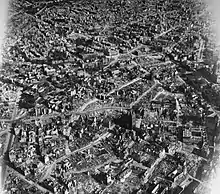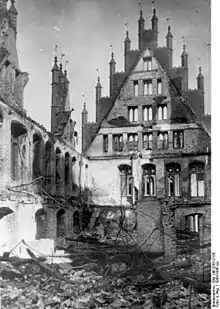Bombing of Hanover in World War II
The Bombing of Hannover was a series of eighty-eight air raids by RAF Bomber Command and the United States Army Air Forces on the German city of Hanover during World War II.[1][2] 4,748 residents and 2,034 others were killed.[3] Around 1,000 aerial mines, 34,000 high explosive bombs, 900,000 incendiary bombs and 50,000 fire bombs were dropped. The heaviest raid was that by the RAF on the night of 8/9 October 1943, killing 1,245 people. This was an example of the carpet bombing of suburban and residential civilian targets laid out in the 14 February 1942 Area Bombing Directive.[4]

At the end of the war 90% of the city centre was destroyed, with 52% of buildings heavily damaged or completely destroyed.[5] A total of 7.5 million cubic metres of rubble had to be removed. Of the 147,222 dwellings recorded at the end of 1939, 51.2% were heavily damaged or totally destroyed, 43.6% lightly or moderately damaged and only 7,489 dwellings (5.2%) completely undamaged.[3] The Aegidienkirche and Nikolaikapelle were both destroyed but it was decided to leave them in ruins after the war as a war memorial
Strategic importance


Before the war Hannover was the thirteenth largest city in Germany and Austria, with 471,000 inhabitants – on average this fell to 287,000 during the war (mainly due to evacuations) and in May 1945 was down to 217,000. It was the headquarters of 19th Infantry Division, military district XI and a military training facility.[6]
Hannover was an important railway junction at the intersection of two major east-west and north-south routes. It was the fifth most active industrial centre in the Third Reich, producing tyres for military vehicles and aircraft and other rubber parts and products in three Continental AG factories. Its Maschinenfabrik Niedersachsen Hannover and Hanomag factories also produced guns and tracked-vehicles.,[7] whilst an AFA (Accumulatoren Fabrik Aktiengesellschaft – laterVARTA) factory built in 1938 produced batteries for submarines and torpedoes from 1940 onwards.[8]
A new Vereinigten Leichtmetallwerke (VLW) factory had been built in 1935 on a site in the Linden-Süd district formerly used by the Hannoversche Waggonfabrik after the latter went bankrupt. The VLW also built a factory in Laatzen outside the city limits in 1936 which was not directly attacked. Two large refineries Deurag and Nerag in Misburg on the northeastern outskirts of the city produced gasoline and motor oils for the Luftwaffe, meaning they were targeted early and continued to be attacked, especially late on in the war.
Raids

Raids on Hannover involved a relatively short flying-time from bases in the United Kingdom and the nearby Steinhuder Meer provided a useful navigational aid. The 78 hectare Maschsee on the southern edge of the city centre was partly covered with wooden boards and artificial islands to make it less recognizable from the air, but the geometrical patterns in the 50 hectare Großer Garten remained undisguised and were used by the RAF's H2S radar from mid 1943 onwards.
1939 and 1940 – initial raids
The first raid was on 4 September 1939, the day after the British declaration of war – it involved just one RAF Armstrong Whitworth Whitley dropping leaflets. On 19 May 1940 the RAF bombed the Misburg refineries, killing nineteen people. 1 August the same year saw the first raid on Hannover itself, with a raid on the Seilerstraße in the south of the city. On 30 September 1940 six planes destroyed several buildings in Wülfel and Linden.
1941
On 10 February 1941, the city was raided by 220 British planes, mainly hitting the eastern district and killing 101 people. Another British raid followed on the night of 15/16 April on the Vahrenwald and Hainholz and on 15/16 June on the VLW-Werk factory and the Misburg refineries. Although these raids damaged the factories' productivity, they were repeatedly able to resume production.
26 July 1943 – Destruction of the city centre

9 October 1943 – The "Black Day"
RAF Bomber Command sent 504 aircraft (Lancasters, Halifaxes, Wellingtons and eight Mosquitos). Many German nightfighters arrived before the attack was over and 27 British aircraft were lost. Conditions over Hannover were clear and the Pathfinders marked the centre of the city accurately with all bombs landing within the built-up area. [9]
"The air raid lasted from 1.05 to 1.45 a.m. on 9th October 1943. The number of planes attacking was 700. They dropped: 80 land-mines, 3000 high explosives, 28,000 phosphor bombs, and 230,000 fire-bombs. The destruction of 3,932 private houses was total; 13,832 houses had severe damage. These figures do not include minor damage, and the many hundreds of devastated industrial complexes and public buildings. The centre of Hanover, including the old medieval town, and the southern district were laid waste. During this night 1,139 people were killed, 6,319 were injured, and 250,000 of the original 500,000 inhabitants were made homeless. The following day the sun stood in the sky but did not shine. A pall of smoke, heat, soot and dust rose and blotted out the sky. The raid on the night of the 8th–9th October 1943 was not the first, and was to be followed by another 88. Each of these brought fear, misery and destruction: but in its extent the night of the 8th–9th October caused the greatest terror of them all."[10]
18 October 1943

In the last of the four big raids against Hanover, 360 Lancasters attacked Hannover but the target area was covered by cloud and the raid was inaccurate "most bombs falling in open country north and north-west of the city".
28 March 1945 – final raid

Bibliography
- (in German) Neue Presse, Hannover: Als die Stadt in Trümmern lag, Serie von Juli bis Oktober 2003
- (in German) Jörg Friedrich: Der Brand. Deutschland im Bombenkrieg 1940–1945. Ullstein-Heine-List, München 2002, ISBN 3-548-60432-3
- (in German) Heinz Koberg: Hannover 1945. Zerstörung und Wiedergeburt. Schlütersche Verlagsgesellschaft, Hannover 1985, ISBN 3-87706-198-2
External links
- (in German) Als Hannover in Trümmern lag Bildergalerie in: Hannoversche Allgemeine Zeitung vom Oktober 2013
References
- (in German) Alfred Gottwaldt: Hannover und seine Eisenbahnen, Alba, Düsseldorf 1992, ISBN 3-87094-345-9, S. 83
- (in German) Heinz Koberg: Hannover 1945. Zerstörung und Wiedergeburt., S. 9
- (in German) Klaus Mlynek, Waldemar R. Röhrbein (ed.s): Hannover Chronik: Von den Anfängen bis zur Gegenwart, Zahlen • Daten • Fakten, Schlütersche, Hannover, 1991
- Jörg Friedrich: Der Brand. Deutschland im Bombenkrieg 1940–1945, S. 83
- (in German) Ausstellung des Volksbund Niedersachsen: „Niedersachsen im Krieg“ – Der Bombenkrieg (pdf, 533 kB)
- (in German) Klaus Mlynek, Waldemar R. Röhrbein (ed.): Stadtlexikon Hannover: Von den Anfängen bis zur Gegenwart, Schlütersche, Hannover 2009, S. 694
- vffwts.de
- Burkhard Nadolny, Wilhelm Treue: VARTA – Ein Unternehmen der Quandt Gruppe 1888–1963, Verlag Mensch und Arbeit München 1964
- "Campaign Diary October 1943", Royal Air Force Bomber Command 60th Anniversary, 6 April 2005, archived from the original on 6 July 2007
- Brigitte Kay, Growing Up in Germany 1924-1949. She describes this as "a translation from the official German record", but does not give a more precise source. A 2013 German newspaper article clearly quoting from the same source is at 9. Oktober 1943: Hannover in Schutt und Asche